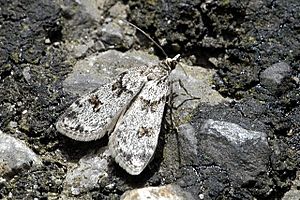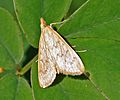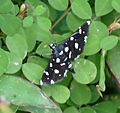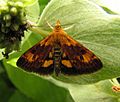Crambidae facts for kids
Quick facts for kids Crambidae |
|
|---|---|
 |
|
| Scoparia ambigualis | |
| Scientific classification |
|
| Kingdom: | Animalia |
| Phylum: | Arthropoda |
| Class: | Insecta |
| Order: | Lepidoptera |
| Superfamily: | Pyraloidea |
| Family: | Crambidae Latreille, 1810 |
| Type species | |
| Phalaena pascuella Linnaeus, 1758
|
|
| Subfamilies | |
|
|
| Diversity | |
| Some 11,630 species | |
The Crambidae are a big family of moths, often called grass moths. They are part of a group of insects called lepidopterans, which includes both moths and butterflies. These moths can look very different from each other.
Some grass moths (from the Crambinae group) like to fold their wings tightly. This helps them hide on grass stems, making them hard to spot. Other types of Crambidae moths are bright and colorful. They often rest with their wings spread out, showing off their patterns.
In the past, Crambidae were sometimes thought to be a smaller group, like a subfamily, within another moth family called Pyralidae (snout-moths). But scientists found a special part in their ears, called the praecinctorium. This part connects two ear membranes in Crambidae moths, but it's missing in Pyralidae moths.
Because of this difference, Crambidae are now considered a full family of their own. There are about 11,630 known species of Crambidae moths. They are grouped into 15 smaller subfamilies and over 1,000 different types, or genera.
Contents
Moths in the Gallery
Crambidae and Humans
Crambid moths are quite common, especially near places where people live. This means they often interact with our farms and gardens. Sometimes they can be helpful, sometimes harmful, and sometimes they don't cause any problems at all.
Helpful Crambids
Some Crambid moths are used to help control unwanted plants. For example, the water hyacinth moth (Niphograpta albiguttalis) helps control the water hyacinth plant (Eichhornia crassipes). Another helpful moth is the water veneer (Acentria ephemerella). It's used to fight against a weed called Eurasian watermilfoil.
There's also the bamboo borer (Omphisa fuscidentalis). Its caterpillars are eaten by people in some parts of the world. This practice is called entomophagy, which means eating insects.
Harmless Crambids
Some Crambid moths simply live their lives without causing any trouble for humans. The mint moth (Pyrausta aurata) is a good example of a harmless crambid. It mostly feeds on mint plants and doesn't usually become a pest.
Harmful Crambids
Many Crambid moth larvae (the caterpillars) like to bore into the stems of plants. They especially target plants from the grass family. Since many important crops, like corn and rice, are grasses, some Crambid species can become pests.
One of the most well-known pest species is the European corn borer (Ostrinia nubilalis). It was brought to the United States in the early 1900s and is now found in many states. Other Crambid moths that can harm crops include:
- The pearl millet stem borer (Coniesta ignefusalis)
- The spotted stalk borer (Chilo partellus)
- The Asiatic rice borer (Chilo suppressalis)
- Sod webworms (different Crambus species)
- Duponchelia fovealis
- The sugarcane borer (Diatraea saccharalis)
- Bean pod borers (different Maruca species)
- The rice white stemborer (Scirpophaga innotata)
- The southwestern corn borer (Diatraea grandiosella)
- The grape leaffolder (Desmia maculalis)
These moths can cause damage to crops, which can be a big problem for farmers.
See also
 In Spanish: Crambidae para niños
In Spanish: Crambidae para niños








